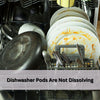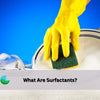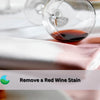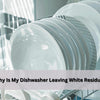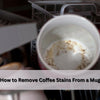What are Phosphates? The Importance of Phosphate Free Cleaning Products
- by Brodie Cook

Phosphates are chemicals used in many cleaning products. They help detergents and soaps work better at a certain cost.
But more people are now choosing phosphate-free options. These products are getting attention for being safer and better for the environment. They show how cleaning can improve without relying on phosphates.
What Are Phosphates and Why Are They Used in Cleaning Products?
Phosphates are chemical compounds made from phosphorus, a naturally occurring element that is necessary for plant growth. They can be processed into synthetic forms for use in cleaning products. These include detergents, dishwashing liquids, laundry detergents and household cleaners.
Phosphates help break down grease, grime, and mineral deposits. This makes cleaning easier, especially in areas with hard water. They also stop soap scum from forming. Soap scum is the filmy residue left behind when soap reacts with minerals in hard water.
Another feature of phosphates is that they create foam. Many people think foam means a product is working well. This gives the impression of better cleaning, even if foam isn’t always necessary.
The most common phosphate is Sodium Tripolyphosphate (STPP). It’s used to boost cleaning power and make detergents work better in tough conditions. STPP has been a go-to ingredient in many products for its effectiveness
The Hidden Costs of Phosphates

Environmental Impact
Phosphates entering water systems act like fertilizer. They cause a quick overgrowth of algae, a process called eutrophication. This overgrowth creates algal blooms that cover the surface of lakes and rivers. These algae blooms block sunlight from reaching underwater plants, disrupting the ecosystem. They may also release toxins that harm aquatic organisms and wildlife, terrestrial animals, and humans. Together, these effects can significantly impact the balance of aquatic environments. As the algae die and decompose, they use up oxygen in the water.
Without oxygen, fish and other aquatic life can’t survive. This creates “dead zones,” where almost nothing can live. For example, the Gulf of Mexico experiences one of the largest dead zones in the world. It happens each year due to nutrient runoff, including phosphates, from rivers like the Mississippi. (source: Epa.gov The Effects: Dead Zones and harmful Algal Blooms)
Tourism and fishing in these areas suffer. Clean water is essential for these industries, and pollution drives people away. Algal blooms also make water unsafe for swimming or drinking, further hurting local communities.
Human Health Risks
The use of phosphates can cause problems for your skin and lungs. People who use phosphate-based cleaners often notice rashes or coughing. These chemicals can also make breathing harder, especially with regular exposure.
Drinking water with phosphates can also be a concern. These chemicals put extra strain on your kidneys and may lead to heart issues over time. Even small, repeated exposure can add up. (Source: WHO Guidelines for Drinking-Water Quality, the PDF)
Phosphates get into drinking water in a few ways. Farms use fertilizers packed with phosphates, and rain washes them into rivers and lakes. Detergents and soaps add more phosphates to the mix. When these go down the drain, they reach wastewater treatment plants. Many plants can’t fully remove them, so they end up in our water. (Source: EPA Nutrient Pollution Reports)
Economic Impact
Phosphates are expensive to clean up. Cities must treat water to remove them, increasing costs for treatment plants. This leads to higher bills for taxpayers. Even then, it's hard to remove.
The costs don’t end there. Algal blooms from phosphate pollution hurt local economies. Businesses near lakes or rivers lose income when tourists stay away. Fishing industries also struggle when waterways become polluted.
Regulations and the Push for Phosphate-Free Cleaning

Phosphates in cleaning products have been a concern for decades. Many countries worldwide have started placing restrictions to protect water systems.
In the United States, states like Maine and Florida began limiting phosphates in the 1970s (already). By 2010, 17 states banned phosphates in dishwasher detergents. These detergents were targeted because they could contribute up to 34% of phosphates in wastewater.
The European Union began acting in 2004. They first required detergents to be biodegradable. Later, in 2013, phosphates were banned in laundry detergents. Dishwashing detergents followed in 2017. (Source: Wikipedia on Phosphates)
Australia also made changes. By 2014, more cleaning products sold there were phosphate-free. These changes helped reduce the impact of phosphates on water systems. (Source: Institute for Sustainable Futures)
Phosphate-Free Cleaners: Then vs. Now
When phosphate-free products first came out, they didn’t win over many users. They made less foam, which some people thought meant they weren’t working. Others complained about residue left behind on dishes or clothes. These early issues gave phosphate-free cleaners a bad reputation, even though they were better for the environment.
Over time, companies improved these products. Today’s phosphate-free options are much better. They clean just as well as traditional cleaners. They break down grease, soften water, and leave surfaces spotless. Brands like Lucent Globe have shown that you don’t need phosphates to get great results. These innovations prove that phosphate-free cleaning has come a long way.
Alternatives to Phosphate-Based Products

We at Lucent Globe offer a range of cleaning products that are phosphate-free and safe for the environment. These products are made to clean effectively while being gentle on your home and the planet. Here’s a closer look at what they offer:
How Phosphate-Free Choices Benefit You and the Planet
Our phosphate-free products offer more than just clean surfaces. They are a smarter choice for your home and community.
These products reduce the chemicals you bring into your home. Without harsh ingredients, they are gentler on your skin and safer for your family. They also avoid leaving behind residues, making everyday cleaning better.
Phosphate-free options also help support communities and the local environment. Cleaner water supports local tourism and farming. Choosing these products is a simple way to protect the spaces we all rely on.

 Dishwashing
Dishwashing Laundry
Laundry Bundles
Bundles Surfaces
Surfaces Toilet
Toilet Handsoap
Handsoap Multi-Purpose
Multi-Purpose Floor
Floor
